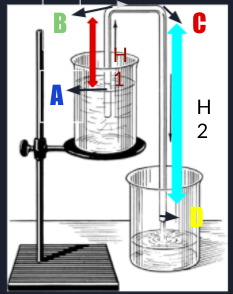This post will be explaining siphon over here in the simplest way possible, with reference to the picture.
The siphon helps in the movement of water upwards against gravity and back down. The siphon moves water from a higher to lower point. This happens because of difference in pressure.
Starting the process–
At first the siphon is filled with the liquid it will transport and then it is put in another container where the liquid reaches.
The siphon can also be activated after putting one end in the container containing liquid, and then sucking the air from it.
Formulae of Pressure-
Pressure = Force/Area
Force (f) = Mass * acceleration (acceleration in this condition is = G)
Density = mass/ volume
Hence Mass = Density*volume
Force = Mass * acceleration
= Density*volume*acceleration
Pressure = Force/area
= Density*volume*acceleration / area (volume by area = Height)
Hence pressure = Density (d) * Height(h) * acceleration (a == g)

Working of siphon–
Point A- Is the point of siphon which is on the water surface. The pressure on point A= atmospheric pressure because it is on the surface of water.
Point B- Is the highest point on the left part of the siphon.
Pressure at point B = pressure at point A – d * h1 * g.
Hence pressure at point B = atmospheric pressure – d*h1*g
Due to difference in pressure between point A and B, where B = lesser pressure – water moves up from point A to B
Point D – Is the opening, the pressure here is equal to atmospheric pressure.
Point C – Is the highest point on the right part of the siphon
Pressure at point C = Pressure at point D – d * g * h2.
Hence pressure at point C = atmospheric pressure – d*h2*g
Since h2 is larger than h1 the pressure at point C is lesser than pressure at point B.
Pressure at point B = Atmospheric pressure – d*h1*g (Atmospheric pressure = pressure A)
Pressure at point C = Atmospheric pressure – d*h2*g (Atmospheric pressure = pressure D)
Since h2 is larger than h1 and d , g are constant
then, point C is having a higher pressure value subtracted from atmospheric pressure
Hence water moves from B to C
Then is pulled down by gravity to point D and then the water leaves the siphon.